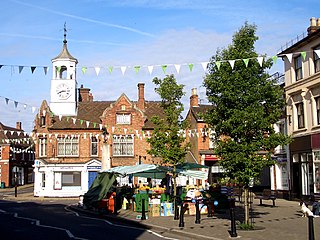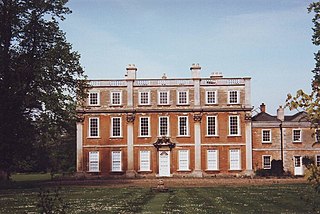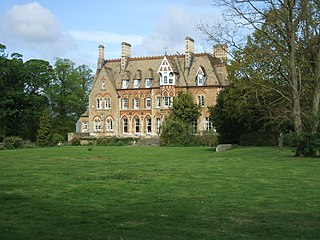Related Research Articles

Ampthill is a town and civil parish in Bedfordshire, England, between Bedford and Luton, with a population estimate of 8,100. It is administered by Ampthill Town Council. The ward of Ampthill which also includes Maulden and Clophill has an estimated population of 13,280 and is administered by Central Bedfordshire Council.

Houghton House is a ruined mansion house in the parish of Houghton Conquest, Bedfordshire. It is a Grade I listed building, positioned above the surrounding countryside, and commands excellent views. Built from 1615 to 1621, it is said that the house was the model for House Beautiful in John Bunyan's The Pilgrim's Progress (1678). It was abandoned in 1794 and stripped of its interiors and roof for sale as building supplies. Today the property is owned by English Heritage, and is open to free public access during daylight hours.

Toddington is a large village and civil parish in the county of Bedfordshire, England. It is situated 5 miles north-north-west of Luton, 4 miles (6 km) north of Dunstable, 6 miles (10 km) south-west of Woburn, and 35 miles north-north-west of London on the B5120 and B579. It is 0.5 miles from Junction 12 of the M1 motorway and lends its name to the nearby motorway service station. The hamlet of Fancott also forms part of the Toddington civil parish.

North East Bedfordshire is a constituency represented in the House of Commons of the Parliament of the United Kingdom since 2019 by Richard Fuller, of the Conservative Party.

Northill is a village and civil parish in the Central Bedfordshire district of the county of Bedfordshire, England about 6.5 miles (10 km) southeast of the county town of Bedford.

Putteridge Bury is a country house on the edge of the built-up area of Luton, Bedfordshire, England but located just over the county boundary in the parish of Offley in Hertfordshire.

Hinwick House is a Grade I-listed Queen Anne country house located about 90 minutes from Central London, near Podington in North Bedfordshire. The estate consists of the Queen Anne main house, the Victorian wing, the Victorian wing extension, garage block, stables, three cottages attached to a clock tower, a walled garden and a period dovecote. The house and estate has a total of 50 rooms. Hinwick House underwent a two-year restoration programme that concluded in 2016.

Houghton Conquest is a village and civil parish located in the Central Bedfordshire district of Bedfordshire, England. The parish also includes the hamlet of How End.
This is a list of high sheriffs of Bedfordshire.

Ickwell is a small, rural village in the Central Bedfordshire district of the county of Bedfordshire, England about 6.5 miles (10 km) south-east of the county town of Bedford.

Upper Caldecote is a village in the Central Bedfordshire district of Bedfordshire, England about 8 miles (13 km) south-east of Bedford.
Melchbourne Preceptory was a priory in Melchbourne, Bedfordshire, England. It was established in the 12th century and disestablished around 1550.
Edworth Manor was a manor in Bedfordshire, England. The manor was mentioned in the Domesday Book. The manor was owned in the 16th & 17th centuries by the Pygott and Hale families. There was a house in the manor, known as 'The Hall' which was home to the Spencer family. John Spencer (c.1505–68) and Ann Merrill leased the house and a farm in the 16th century.

Ampthill Park and Ampthill Park House is a country estate in Ampthill, Bedfordshire, England. The park was opened to the public after the Second World War.
(Greensand Cycleway) Signs for this route appeared in the first half of 2014. It covers roughly 40 miles (64 km), using minor roads and runs roughly in parallel with its sister walk, the Greensand Ridge Walk. The route traverses Bedfordshire, making brief forays into the neighbouring counties of Cambridgeshire and Buckinghamshire. Its southern endpoint is at Leighton Buzzard and the route runs north-east to Sandy. The waymarker for this route is simply Greensand Cycleway and the depiction of a bicycle on a brown background. There are some smaller, circular waymarkers employed to ensure continuity of the route for cyclists.

Milton Ernest Hall is a large grade I listed country house in the village of Milton Ernest, Bedfordshire, England. It now serves as a nursing home.

Southill Park contains the site of late medieval Gastlings or Gastlyns Manor House and is the name given to a country house in Southill, Bedfordshire, its adjoining privately owned gardens and separate public parkland; it includes a lake and woodland. Its focal point is an early Georgian house, for disambiguation known as Southill Park House which is a heritage-listed building in the highest category. The parkland has legal designations in heritage and plant or wildlife protection. Further structures in the grounds have heritage protection including the follies of a Tuscan architecture temple and a partially stone-faced bridge, both designed by Henry Holland.

Moreteyne Manor is a 15th-century manor house in Marston Moretaine, Bedfordshire, England. For many years it was used as a farmhouse but is now a country house restaurant. It is a Grade II* listed building.

Kempston gravel pit railway was a narrow-gauge tramway which connected a gravel pit in the Hill Grounds area of Kempston, Bedfordshire to Bedford Road. There are a small number of records of its operation in the late 1910s and 1920s and perhaps some years early. The terminus lay by the entrance to the Robert Bruce School site on what is now Bedford Road.
References
- ↑ Ickwell Bury Archived 2014-04-26 at the Wayback Machine at bedfordshire.gov.uk (accessed 26 April 2008)
- 1 2 Kelly's Directory of Bedfordshire (Kelly, 1898)
- ↑ Newcombe, Suzanne (2019). Yoga in Britain: Stretching Spirituality and Educating Yogis. Bristol, England: Equinox Publishing. p. 211. ISBN 978-1-78179-661-0.
52°05′45″N0°19′43″W / 52.0959°N 0.3285°W